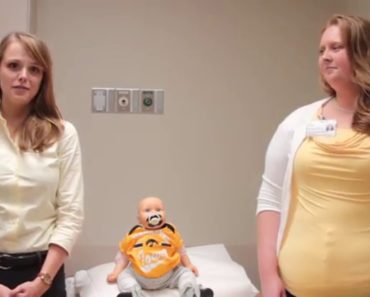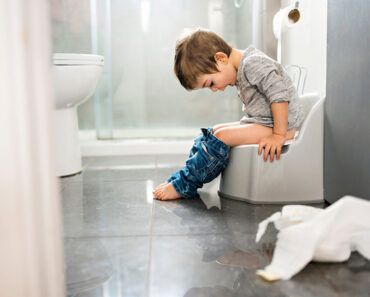A baby requires head support in the initial months of life since their neck muscles are not strong enough to hold their head. They can control their head by three months if they are sitting with support (1). By six months, their neck muscles become stronger, and they can turn their head side to side and hold their head up.
The achievement of several developmental milestones, such as rolling, sitting, crawling, and walking, depends on the baby’s ability to hold their head without support. You may consult a pediatrician if your baby fails to hold their head up by five months of age.
Read this post to know more about how a baby develops head control, how to help a baby to hold their head up, precautions to take, and what comes next after a baby develops reasonable head control.
How Does A Baby Develop Head Control?
Head control is a gradual process. A newborn can’t hold their head without support, and their head will flop back as their neck muscles are weak. You may have to use your hands to support your baby’s head while holding them during this period.
Babies may try to lift their heads when they lay on their stomach by the end of the first month (2). They may also try to turn their head towards sounds. Between the end of the first and third month, most babies try to raise their heads when lying on their tummy.
A three-month-old baby can lift their head and chest with their hands’ support while lying on their stomach. They may also hold their head up when they are on a baby sling or a car seat. However, each baby achieves developmental milestones at an individual pace. You may have to wait for about five to six months for your baby to hold their head without support.
How To Encourage A Baby To Hold Their Head Up?
You can encourage your baby to hold their head from the third month onwards. The following methods may help your baby to hold their head up (1).
- You can lay the baby on their back and slowly make them sit by gently pulling their hands. This method may help a four- to five-month-old baby exercise and develop control of their head.
- You can hold them next to your shoulder while sitting on a chair. It may help your baby raise their head easily.
- Five- to six-month-old babies develop good control over their heads. You may encourage them by making sounds or calling them from other directions. The baby may lift their head or move it from side to side to follow your voice.
- You can increase your baby’s tummy time since they tend to hold their head up when they lay on the tummy. Keep some toys near your baby to make them lift the head to reach it.
- You can place your five- to six-month-old baby in a supported chair or your lap. It may make it easier for the baby to hold their head in the sitting position.
- You may try multiple activities for better exercise and development of the baby’s head control.
Precautions To Take While Helping The Baby To Hold Their Head Up
You should not try head control methods on a newborn baby (baby younger than three months). Support your baby’s neck and head with your hand until they develop head control.
Babies may roll over while trying to move their heads. Therefore, place the baby on a sheet on the floor when trying various encouragement activities. Babies lying on bed or dressing table without rails may have an increased risk of falling while moving their heads and bodies towards sounds or toys.
What To Expect After Holding Their Head Up?
Head control is one of the major developmental milestones for a baby since it facilitates the achievement of other abilities. After developing head control, your baby will gradually learn to roll over, sit up, crawl, and walk.
Babies also require head control to eat solid food since they have to sit up and keep their heads up to consume solids. You can begin to wean your baby after six months of exclusive feeding; that is the time when most babies usually develop good head control and sit without support (3).
When To Worry If A Baby Can’t Hold Their Head Up?
You may consult a pediatrician if your five-month-old baby cannot hold their head up. Although most babies develop head control by the age of five to six months, skills may vary in each baby. Therefore, do not panic if your baby does not seem to have the same head control skills as their peers.
Head control is often assessed periodically, along with other movements and posture. Pediatricians may inform you if there are any concerns about it and may arrange a follow-up visit.
Premature babies (babies born before 37 weeks) may reach this milestone later than other babies. Speak to the pediatrician for timelines of developmental milestones according to your premature baby’s adjusted age.
What Is Head Lag In Babies?
Head lag is when a baby’s head is not righted and lags behind their trunk due to poor neck and head control. A baby with head lag will have a droopy or floppy head when pulled to sit from a laid-back position. An infant without head lag will keep their head in line with their shoulders when pulled to sit (4).
Preterm infants tend to have head lag more than full-term babies (5). Head lag may indicate developmental problems, including delays in cognitive and motor development. Sometimes, a head lag may indicate autistic spectrum disorder (ASD). However, it can only be confirmed by the age of two years (6).
Although head lag at the age of six months may indicate poor motor development, some babies may achieve good head control a little later without any consequences. Be watchful for other developmental milestones of your baby. If you have any concerns, speak to a pediatrician.
Head control is an essential motor skill and paves the way for other developmental milestones of your baby. Most babies can hold their heads up easily by six months, which is also the age when they can sit unsupported and eat solids. Adequate play and tummy time provide plenty of exercise and encouragement for your baby to hold their head up gradually.

































